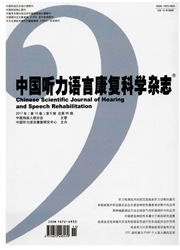

 中文摘要:
中文摘要:
目的构建人野生型CX30红色荧光表达载体,将Cx26野生型和突变型分别与CX30共同转染HEK293细胞,为揭示Cx26--235delC的杂合突变患者的发病机制提供实验依据。方法构建pCx30--IREs2-DsRed—Express真核表达载体,将pcx30—IREs2-DsRed—ExPress分别与pCx26--EGFP或pCx26--235deIC--EGFP以1:1的比例用脂质体法转染HEK293细胞,转染48h后在激光共聚焦显微镜下观察结果,计算同时表达红色和绿色的细胞阳性率,卡方检验比较两组阳性率的差异。结果pCx30--IRES2--DsRed--Express与pCx26--EGFP共同转染HEK293细胞后,同时出现红色和绿色荧光的细胞占全部转染阳性细胞的27.32%(91/333)。pCx30—IRES2--DsRed--Express与pCx26--c235deIC--EGFP共同转染HEK293细胞后,同时表达红色与绿色信号的细胞占全部阳性细胞的2.19%(4/183),明显低于两种野生型质粒共同转染的阳性率,经卡方检验两者差异具有显著性意义(x2=52.89,P〈0.01)。结论Cx26发生C.235deIC突变后,丧失了与野生型Cx30形成异型性缝隙连掇gapjunctions,GJs)的能力,使异型性GJs的总数显著下降,导致耳蜗失去了重要的细胞间联系通道,推测可能与部分c.235delC杂合子耳聋的发生有关。
 英文摘要:
英文摘要:
Objective To construct wild-type GJB6 gene red fluorescent vector, and transfect it into HEK293 cells with wild-type Cx26 or c.235delC EGFP fusion protein vector, thus providing evidences for the research on the mechanism of c.235delC heterozygote's deafness. Methods Cx30 coding sequence was amplified by PCR and cloned into plRES2-DsRed-Express vector in vitro. HEK293 cells were transfected with pCx30-1RES2-DsRed-Express and pCx26- EGFP in the proportion of 1:1, or pCx30-IRES2-DsRed-Express and pCx26-C.235 delC-EGFP in the same proportion with the liposome complex method. The transient expression of EGFP and DsRed was observed under confocal microscope 48 h later. Chi-square test was used to compare the difference between the two groups. Resuits When transfected with Cx26 and Cx30, the red fluorescent signals were distributed uniformly in the cell membrane together with the green ones in most of the transfected cells. But few coexpression of red and green fluorescence was observed in cells cotransfected with Cx30 and pCx26-C.235 delC. The coexpression positive rates of the two groups were 27.32%(91/333)and 2.19%(4/183),respectively. According to the Chi-square test, there was significant difference between the two groups (x2=52.89, P〈0.01). Conclusion Cx26 cannot form heterotypic GJs with wild-type Cx30 when c.235delC mutation occurred, which may result in the loss of the most efficient communication channel between cochlear cells. It may provide another explanation for the c.235deIC heterozygote's hearing loss in Chinese people.
 同期刊论文项目
同期刊论文项目
 同项目期刊论文
同项目期刊论文
 期刊信息
期刊信息
